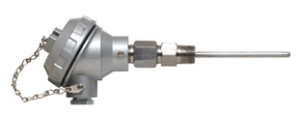Thermocouples
Thermocouple operation is based on the fact that when wires of two different materials are joined together at one end, and placed in a temperature gradient, a thermoelectric voltage is observed. Various materials are used to obtain the best output for any given temperature range and these are described by the ISA letters T, J, E, K, etc. Various sensor elements, sheath materials, probe constructions and mounting styles are available.
| SERIES | DESCRIPTION | RANGE F.S. |
| J Type | Iron vs Copper Nickel (Constantan) | 0° C to +760° C |
| K Type | Nickel-Chromium vs Nickel-Aluminium | -200° C to +1260° C |
| E Type | Nickel-Chromium vs Copper-Nickel | -200° C to +870° C |
| T Type | Copper vs Copper-Nickel (Constantan) | -200° C to +370° C |
| N Type | Nickel-Chromium-Silicon vs Nickel-Silicon-Magnesium | 0° C to +1260° C |
| S/R Type | Platinum-Rhodium vs Platinum | 0° C to +1480° C |
| B Type | Platinum-30% Rhodium vs Platinum-6% Rhodium | +870° C to +1700° C |
| C Type | Tungsten-5% Rhenium vs Tugsten-26% Rhenium | 0° C to +2315° C |

There are several choices to make in the selection of any Conax Technologies thermocouple assembly. Firstly we would need to know the thermocouple type which would usually be dictated by the required temperature measurement. Secondly we would need to know your choice of sheath material and size, both diameter and length. Then whether you need a grounded or ungrounded tip and whether you needed a reduced tip, or even bare wires to enable faster readings. Termination styles vary from simple wire connections, through cables assemblies, to fitted terminal head boxes with or without electronic modules. Mounting considerations might also include the use of a pressure sealing gland which Conax Technologies also manufacture.
The choice given all these variations is very large, so please ask for our help in sorting out the best solution for you.
Comparison of Sensor types
| THERMOCOUPLE | RTD | |
| ADVANTAGES |
|
|
| DISADVANTAGES |
|
|

 D5 Creation
D5 Creation